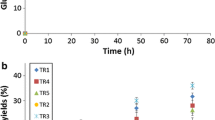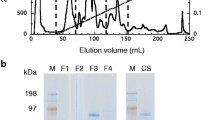Abstract
Mutant forms of recombinant endoglucanase II (EG II, N194A), cellobiohydrolase I (CBH I, N45A) and cellobiohydrolase II (CBH II, N219A) from Penicillium verruculosum with enhanced cellulase activities, achieved by engineering of enzyme N-glycosylation sites in our previous studies, were used as components of the binary and ternary mixtures of cellulases in hydrolysis of Avicel and milled aspen wood. Using the engineered forms of the enzymes at a dosage of 10 mg/g substrate resulted in significant boosting of the glucose release from cellulose in the presence of excess β-glucosidase relative to the performance of the corresponding wild-type mixtures at the same loading. The boosting effects reached 11–40% depending on the reaction time and substrate type. In hydrolysis of both cellulosic substrates by the binary mixtures of cellulases, all the enzyme pairs exhibited synergism. The magnitude of the synergistic effects (Ks) did not depend notably upon the induced mutations in the enzymes, and they were in the range of 1.3–1.8 for the combinations of EG II with CBH I (or CBH II), and 2.3–2.9 for the CBH I–CBH II pair. The results of this study should provide a basis for the development of a more effective fungal strain capable of producing cellulase cocktails with enhanced hydrolytic performance against lignocellulosic materials.




Similar content being viewed by others
References
Adney WS, Jeoh T, Beckham GT, Chou YC, Baker JO, Michener W, Brunecky R, Himmel ME (2009) Probing the role of N-linked glycans in the stability and activity of fungal cellobiohydrolases by mutational analysis. Cellulose 16:699–709
Billard H, Faraj A, Ferreira NL, Menir S, Heiss-Blanquet S (2012) Optimization of a synthetic mixture composed of major Trichoderma reesei enzymes for the hydrolysis of steam-exploded wheat straw. Biotechnol Biofuels 5:9
Boisset C, Pétrequin C, Chanzy H, Henrissat B, Schülein M (2001) Optimized mixtures of recombinant Humicola insolens cellulases for the biodegradation of crystalline cellulose. Biotechnol Bioeng 72:339–345
Bommarius AS, Sohn M, Kang Y, Lee JH, Realff MJ (2014) Protein engineering of cellulases. Curr Opin Biotechnol 29:139–145
dos Santos LV, de Barros Grassi MC, Gallardo JCM, Pirolla RAS, Calderón LL, de Carvalho-Netto OV, Parreiras LS, Camargo ELO, Drezza AL, Missawa SK, Teixeira GS, Lunardi I, Bressiani J, Pereira GAG (2016) Second-generation ethanol: the need is becoming a reality. Ind Biotechnol 12:40–57
Dotsenko AS, Gusakov AV, Volkov PV, Rozhkova AM, Sinitsyn AP (2016a) N-Linked glycosylation of recombinant cellobiohydrolase I (Cel7A) from Penicillium verruculosum and its effect on the enzyme activity. Biotechnol Bioeng 113:283–291
Dotsenko AS, Gusakov AV, Rozhkova AM, Sinitsyna OA, Nemashkalov VA, Sinitsyn AP (2016b) Effect of N-linked glycosylation on the activity and other properties of recombinant endoglucanase IIa (Cel5A) from Penicillium verruculosum. Protein Eng Des Sel 29:495–502
Fox JM, Jess P, Jambusaria RB, Moo GM, Liphardt J, Clark DS, Blanch HW (2013) A single-molecule analysis reveals morphological targets for cellulase synergy. Nature Chem Biol 9:356–361
Gusakov AV (2013) Cellulases and hemicellulases in the 21st century race for cellulosic ethanol. Biofuels 4:567–569
Gusakov AV, Salanovich TN, Antonov AI, Ustinov BB, Okunev ON, Burlingame R, Emalfarb M, Baez M, Sinitsyn AP (2007) Design of highly efficient cellulase mixtures for enzymatic hydrolysis of cellulose. Biotechnol Bioeng 97:1028–1038
Gusakov AV, Dotsenko AS, Rozhkova AM, Sinitsyn AP (2017) N-Linked glycans are an important component of the processive machinery of cellobiohydrolases. Biochimie 132:102–108
Igarashi K, Uchihashi T, Koivula A, Wada M, Kimura S, Okamoto T, Penttilä M, Ando T, Samejima M (2011) Traffic jams reduce hydrolytic efficiency of cellulase on cellulose surface. Science 333:1279–1282
Korotkova OG, Semenova MV, Morozova VV, Zorov IN, Sokolova LM, Bubnova TM, Okunev ON, Sinitsyn AP (2009) Isolation and properties of fungal β-glucosidases. Biochemistry 74:569–577
Morozova VV, Gusakov AV, Andrianov RM, Pravilnikov AG, Osipov DO, Sinitsyn AP (2010) Cellulases of Penicillium verruculosum. Biotechnol J 5:871–880
Payne CM, Knott BC, Mayes HB, Hansson H, Himmel ME, Sandgren M, Ståhlberg J, Beckham GT (2015) Fungal cellulases. Chem Rev 115:1308–1448
Peterson GL (1979) Review of the Folin phenol protein quantitation method of Lowry, Rosebrough, Farr and Randall. Anal Biochem 100:201–220
Proskurina OV, Korotkova OG, Rozhkova AM, Matys VY, Koshelev AV, Okunev ON, Nemashkalov VA, Sinitsyna OA, Sinitsyn AP (2013) Application of the “fusion” approach for the production of highly efficient biocatalysts based on recombinant strains of the fungus Penicillium verruculosum for the conversion of cellulose-containing biomass. Catal Ind 5:327–334
Sinitsyn AP, Gusakov AV, Vlasenko EY (1991) Effect of structural and physico-chemical features of cellulosic substrates on the efficiency of enzymatic hydrolysis. Appl Biochem Biotechnol 30:43–59
Sinitsyn AP, Korotkova OG, Sinitsyna OA, Rozhkova AM, Dotsenko GS, Proskurina OV, Osipov DO, Kondrat’eva EG, Chekushina AV (2016) Optimizing the composition of cellulase enzyme complex from Penicillium verruculosum: enhancing hydrolytic capabilities via genetic engineering. Catal Ind 8:101–106
Trudeau DL, Lee TA, Arnold FH (2014) Engineered thermostable fungal cellulases exhibit efficient synergistic cellulose hydrolysis at elevated temperatures. Biotechnol Bioeng 111:2390–2397
van Dyk JS, Pletschke BI (2012) A review of lignocellulose bioconversion using enzymatic hydrolysis and synergistic cooperation between enzymes—factors affecting enzymes, conversion and synergy. Biotechnol Adv 30:1458–1480
Volkov PV, Rozhkova AM, Gusakov AV, Sinitsyn AP (2014) Homologous cloning, purification and characterization of highly active cellobiohydrolase I (Cel7A) from Penicillium canescens. Prot Expr Purif 103:1–7
Acknowledgements
This work was supported by the Russian Science Foundation (Grant No. 16-14-00163).
Author information
Authors and Affiliations
Corresponding author
Ethics declarations
Conflict of interest
The authors declare that they have no conflict of interest.
Rights and permissions
About this article
Cite this article
Dotsenko, A., Gusakov, A., Rozhkova, A. et al. Enzymatic hydrolysis of cellulosic materials using synthetic mixtures of purified cellulases bioengineered at N-glycosylation sites. 3 Biotech 8, 396 (2018). https://doi.org/10.1007/s13205-018-1419-4
Received:
Accepted:
Published:
DOI: https://doi.org/10.1007/s13205-018-1419-4




